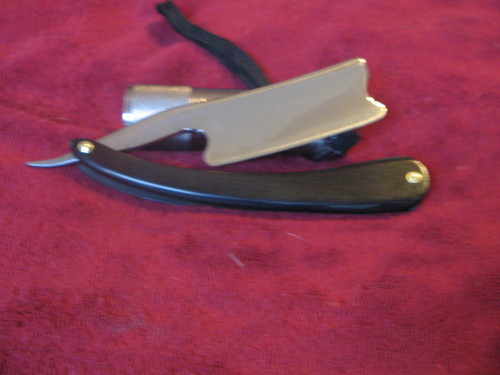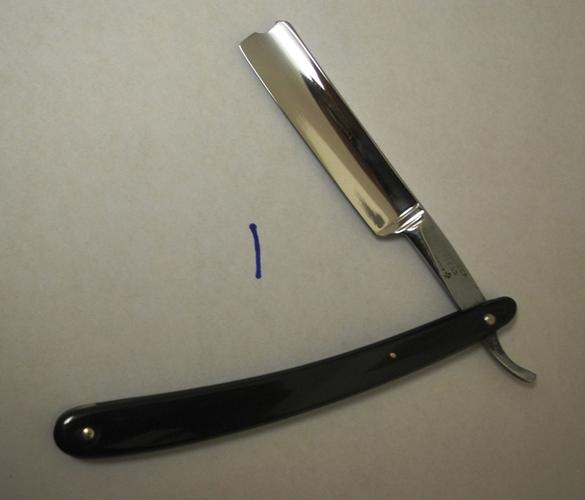Results 1 to 10 of 80
Thread: Douglas cutlery
Hybrid View
-
12-17-2011, 07:06 PM #1Junior Member

- Join Date
- Dec 2011
- Posts
- 7
Thanked: 0 Douglas cutlery
Douglas cutlery
Hey everyone I just made an impulse buy on this travel razor. I don't know much about it except my eye really liked it. Let me know what you think.
-
12-17-2011, 07:25 PM #2

Did you get that from Bishop Pickle???? Douglas Cutlery has done 2 of my razors, one a Reynolds restore, the other a custom. I love them both to death, and your's looks a lot like my Reynolds. Doug does a great job and cares about his work.
Excellent buy!! I like it!!!
Mike-- Any day I get out of bed, and the first thing out of my mouth is not a groan, that's going to be a good day --
-
12-17-2011, 09:10 PM #3Junior Member

- Join Date
- Dec 2011
- Posts
- 7
Thanked: 0
I did get it from Bishop on their eBay listing. I'm glad you like yours. It makes it even more exciting for me.
-
12-26-2011, 09:25 PM #4

Hey Hd172,
I just bought a razor from Douglas Cutlery as well, and I'm really excited! Have you shaved with this one yet? If so, how was it???
-Robert
-
12-27-2011, 01:37 AM #5

Did you have one made, or buy off of ebay?? I have both from Douglas Cutlery now. Both are wedge or near wedge razors, and shave incredible, as any well honed wedge is expected to!!
I love both of mine, I have a really old Reynolds that Douglas restored in walnut micarta, and a hand made custom made just for me that is a spanish point near wedge. Incredible razors, and incredible shavers.
Highly recommended!!!
M-- Any day I get out of bed, and the first thing out of my mouth is not a groan, that's going to be a good day --
-
The Following User Says Thank You to mjhammer For This Useful Post:
RobertHardy (12-27-2011)
-
12-27-2011, 05:26 AM #6

I just bought this one off of ebay this afternoon. I actually hadn't thought of buying it when I first saw it because it seemed too cheap to truly be a hand crafted razor. Plus I'm generally wary of new razors on ebay in the first place. But when I had a Filarmonica DT13 snatched out from under me at the last second (still a little mad), I decided to take another look at this and do some research about the respectability of Douglas Cutlery. I'm so glad I did, because if these shave as good as they look, and as well as everyone says they do, then I just scored a fantastic, one of a kind razor for an unbelievable price!

Thanks so much for your recommendation earlier in this thread because that's partly why I bought the razor. Also, it's nice to see some other folks on this site from Colorado!
Thanks again, and Happy Holidays!
-Robert
-
12-16-2012, 03:34 PM #7Junior Member

- Join Date
- Nov 2012
- Posts
- 2
Thanked: 1
Thanks you guys! I was also skeptical when I saw a sweet looking 8/8 axe head with black micarta scales. Your feedback made it easy for me to pull the trigger!

-
The Following User Says Thank You to John02021 For This Useful Post:
bishpick1 (12-17-2012)
-
12-17-2012, 08:18 PM #8

Where do you get these? How do I find them on ebay?
-
06-19-2013, 05:33 PM #9This is not my actual head.



- Join Date
- Nov 2009
- Location
- Middle of nowhere, Minnesota
- Posts
- 4,624
- Blog Entries
- 2
Thanked: 1371
It's good to know that they've finally developed metalurgical technology allowing blades to be thicker.
Strange women lying in ponds distributing swords is no basis for a system of government.
-
The Following User Says Thank You to HNSB For This Useful Post:
Hirlau (06-19-2013)
-
06-19-2013, 07:24 PM #10

When I see a thread started with members having very low post counts & flooding it with examples of products from one particular manufacturer, I take notice. It's not that I'm immediately suspicious of intent; it's just that I don't want to miss out on the latest , greatest product. With that said, I'm glad there are many razor manufacturers out there. There seems to be a razor out there for everybody.
Now that Douglas Cutlery razors have been placed in this thread for us to enjoy & review, let me make a few comments based upon the information & photos provided.
High carbon steel, a pillar of our civilization for centuries, has taked a beating in this thread. I will not argue Metallurgy with anyone, I have little knowledge of it. But let me show you a picture of some thin grind high carbon steel, that I know for a fact was in use between 1830 to 1840.

It sure has taken a beaten & I'm surprised it did not wear itself out before 1850.
It gave me the best shave I've had to date, a month ago.
The steel in Douglas razors, carbon-chromium alloys, may be the "cat's meow" of steels today, may be? Time will tell if these razors are sought after 100 years from now.
One thing that I can tell from the photos in this thread, is that the individual scaling these razors,,,should be fired. They simply look horrible to me. Roughly cut scales with a pin job that well,,,, I just can't say,,,,,,,
More time on the total package, instead of debating carbon-chromium alloys vs high carbon steel, might get more Douglas razors in the hands of wet shavers.
Tradition means everything to me when choosing a razor. Tradition cannot be obtained overnight and with a few happy customers,,,,,sorry it just cannot be obtained. I wish the best of luck to the owner of Douglas Cutlery.
If God gave you the skill & "1" hour to fly a plane, would you choose the latest F-35 Joint Strike Fighter?
or
would it be the P-51D Mustang??????????
Do I really need to ask,,,

Last edited by Hirlau; 06-19-2013 at 07:39 PM.
-
The Following User Says Thank You to Hirlau For This Useful Post:
bishpick1 (06-19-2013)


 89Likes
89Likes LinkBack URL
LinkBack URL About LinkBacks
About LinkBacks






 Reply With Quote
Reply With Quote



